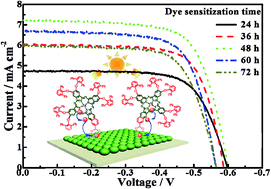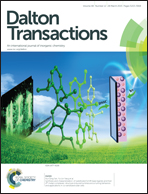Synthesis of zinc phthalocyanine with large steric hindrance and its photovoltaic performance for dye-sensitized solar cells†
Abstract
A zinc phthalocyanine (ZnPc) derivative (Zn-tri-PcNc-8) containing tri-benzonaphtho-condensed porphyrazine with one carboxylic and six diphenylphenoxy peripheral substitutions was designed and synthesized as a sensitizer for dye-sensitized solar cells (DSSCs). For the purpose of extending the absorption spectra while minimizing the formation of ZnPc molecular aggregates, bulky 2,6-diphenylphenoxy groups were used as electron donor moieties, and the carboxylic group as an anchoring group to graft the sensitizer onto the semiconductor. It was found that a TiO2-based solar cell sensitized by Zn-tri-PcNc-8 shows a maximum incident photon-to-current conversion efficiency in the red/near-IR light range (650–750 nm), and a solar cell sensitized at near room temperature (30 °C) for 48 h exhibits the best efficiency (3.01%). The efficiency was much higher than that (1.96%) for a solar cell sensitized by its analogue (Zn-tri-PcNc-2) having one carboxyl and three tert-butyl groups without chenodeoxycholic acid (CDCA), indicating that the introduction of six bulky diphenylphenoxy substitutions with large steric hindrance in the ZnPc macrocycle can effectively suppress the molecular aggregates, thus resulting in an improved conversion efficiency. The present results shed light on an effective solution to adjust the ZnPc property via chemical modification such as changing the “push–pull” effect and adding large steric hindrance substituents to further improve the efficiency of the phthalocyanine-sensitized solar cell.


 Please wait while we load your content...
Please wait while we load your content...